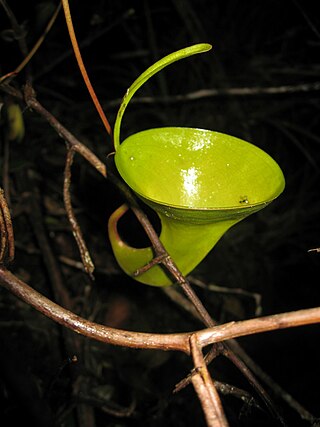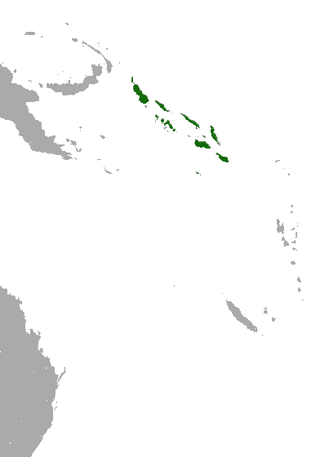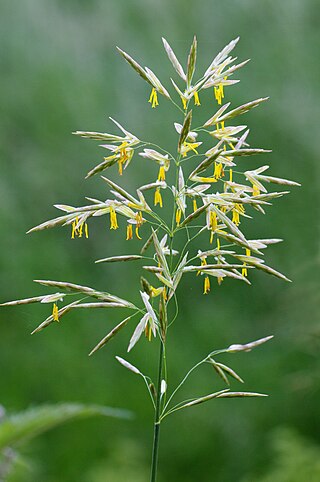
Bromus is a large genus of grasses, classified in its own tribe Bromeae. They are commonly known as bromes, brome grasses, cheat grasses or chess grasses. Estimates in the scientific literature of the number of species have ranged from 100 to 400, but plant taxonomists currently recognize around 160–170 species.

The water deer is a small deer species native to Korea and China. Its prominent tusks, similar to those of musk deer, have led to both subspecies being colloquially named vampire deer in English-speaking areas to which they have been imported. It was first described to the Western world by Robert Swinhoe in 1870.

Nepenthes inermis is a tropical pitcher plant endemic to the Indonesian island of Sumatra. The specific epithet inermis is Latin for "unarmed" and refers to the upper pitchers of this species, which are unique in that they completely lack a peristome.

Stomatosuchus is an extinct stomatosuchid neosuchian from the Late Cretaceous (Cenomanian) of Egypt. Much of what is known about Stomatosuchus has been inferred from the related genus Laganosuchus.

Nepenthes × pyriformis is a natural hybrid involving N. inermis and N. talangensis. It is known only from Mount Talang in Sumatra, to which N. talangensis is endemic. Nepenthes talangensis was only described as a distinct species in 1994. Prior to this it was placed within N. bongso and some of the older literature identifies this hybrid as N. bongso × N. inermis.

The Solomon's naked-backed fruit bat is a species of megabat in the family Pteropodidae. It is endemic to the Solomon Islands.

The highlands punaré is a caviomorph rodent of South America from the spiny rat family. It is endemic to gallery forest, savanna and rocky outcrop habitats in Bahia State within the Caatinga ecoregion of eastern Brazil at elevations from 260 m to 1030 m. It sometimes nests and often takes refuge in crevices in rock formations, as means of both predator avoidance and moderating temperature extremes. The species tolerates a degree of habitat disturbance. Although hunted, it is considered common throughout its range. Its karyotype has 2n = 26 and FN = 48.

Bromus inermis is a species of the true grass family (Poaceae). This rhizomatous grass is native to Europe and considered invasive in North America.

Sebastes inermis, the Japanese red seaperch or dark-banded rockfish, is a species of marine ray-finned fish belonging to the subfamily Sebastinae, the rockfishes, part of the family Scorpaenidae. It is found in the northwestern Pacific Ocean. This species is known as mebaru in Japan and as bollak (볼락) in Korea.

Dactyloscopus crossotus, the bigeye stargazer, is a species of sand stargazer native to the coastal Atlantic waters of Florida, United States and from the Bahamas to Brazil where it prefers sandy beaches at depths of from 0 to 3 metres, occasionally down to 8 metres (26 ft). It buries itself in the sand to ambush prey, leaving only its eyes, mouth and nose exposed. It can reach a maximum length of 7.5 centimetres (3.0 in) TL.

Sepiella inermis is a species of cuttlefish in the family Sepiidae. It is indigenous to the Indo-Pacific region. In this region, S. inermis is an economically important species, and is sold and eaten.

Crossotus is a genus of longhorn beetles of the subfamily Lamiinae.
Crossotus albicollis is a species of beetle in the family Cerambycidae. It was described by Félix Édouard Guérin-Méneville in 1844. It is known from Ethiopia, Burkina Faso, Chad, the Central African Republic, Ghana, Ivory Coast, Cameroon, Senegal, Mali, Morocco, Niger, Nigeria, Kenya, Mauritania, and Western Sahara.
Crossotus brunneopictus is a species of beetle in the family Cerambycidae. It was described by Fairmaire in 1891.
Crossotus klugi is a species of beetle in the family Cerambycidae. It was described by William Lucas Distant in 1892. It is known from Botswana, South Africa, Namibia, Mozambique, and Zimbabwe.
Crossotus strigifrons is a species of beetle in the family Cerambycidae. It was described by Fairmaire in 1886. Its average lifespan is 2 years and its body is 12 – 18 mm in length.

Crossotus stypticus is a species of beetle in the family Cerambycidae. It was described by Francis Polkinghorne Pascoe in 1869. It is known from Mozambique, Botswana, South Africa, Namibia, and Tanzania.
Crossotus sublineatus is a species of beetle in the family Cerambycidae. It was described by Gestro in 1892. It is known from Chad, Algeria, Mauritania, Djibouti, Ethiopia, Somalia, Mali, Morocco, Kenya, Niger, Senegal, and Sudan.
Crossotus ugandae is a species of beetle in the family Cerambycidae. It was described by Breuning in 1936. It is known from Kenya and Somalia.

Crossotus vagepictus is a species of beetle in the family Cerambycidae. It was described by Fairmaire in 1886. It contains the varietas Crossotus vagepictus var. niveicollis.












